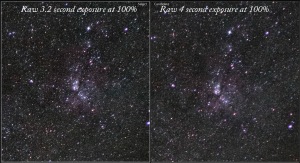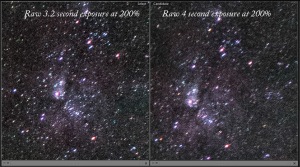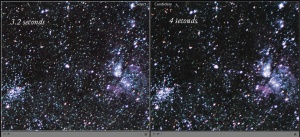Tags
astrophotography, Firmware v 3.3, Median filtering, Sony A7RII, Sony A7SII, Star-eater algorithm
While I’m not a hard-core astro-photographer, I have to confess that for me there are few experiences that come close to standing out in a landscape far from city lights, observing and photographing the night sky. There’s something primeval by way of the connection that it provides with the universe – and with those generations from the past who, without means to easily light their rooms, must have been keen observers of the night skies and their periodic changes in the arrangement of moon, planets and stars.
Over recent months, I’d begun to pursue photography of the night skies over New Zealand with a little more commitment, exploring the astrophotography websites to hone my skills both in image capture and processing. And that began to pay off with some results that begin to capture for me something of the mysteries of what I see above me in our National Parks on a clear, moonless night. That is until I come across the words ‘star-eater algorithm! – and discovered the veritable can of worms that has been opened up by Sony’s latest firmware (3.3) for its Sony A7RII and A7SII cameras.
What is the star-eater algorithm?
The exact nature of Sony’s star-eating algorithms has been analysed and described in a great detail elsewhere, with Jim Kasson’s website (here) containing probably the most detailed examination of what it does. Otherwise, try a web search for “Sony A7R star-eating”.
In brief, the star-eating algorithm is a blanket modification of the raw image that comes off the camera sensor, and is probably designed to deal both with the noise that occurs particularly with longer exposures, and with those pesky pixels that begin to cease functioning in any digital camera with time. The catch is that this filter not only deals to noise and dead pixels – it also destroys much of the fine-scale digital data that describes those small features of the night sky, i.e., stars – hence the name! As a consequence, the ‘raw’ file no longer contains the data returned from the sensor, but a filtered version of it that is now missing the most important detail that astrophotographers are targeting.
Changes in firmware 3.3
So why the reference to firmware version 3.3?
From various descriptions on the internet, it appears that in previous versions of their firmware for the A7RII and A7SII, Sony applied their median filtering algorithm only to long exposures shot with the bulb setting. Exposures shot on manual or aperture priority out to 30 seconds were not affected, so that raw files shot with shorter exposures contained the raw data delivered by the sensor (provided that excessive ISO’s were not used).
That all changed in firmware version 3.3, the release notes for which (here) only identify changes for radio control of lighting, improvements for temperature control, and a vague improvement in ‘overall stability and operability of the camera’. Ominously, Sony warn that installation of this firmware upgrade is permanent and cannot be reversed – we’ll come back to that later!
As users began to implement this update on their Sony cameras, disturbing reports began to surface in the astrophotography community (here) – it appeared that Sony had extended their application of median filtering used with bulb exposures so that it now affected all exposures longer than 3.2 seconds. In short, once version 3.3 of the firmware has been installed on an A7RII or A7SII, it seems that any exposure of four seconds or longer no longer delivers true raw-format data – only pretend raw-format data in which much of the fine detail of objects such as stars is very substantially degraded.
Impacts of the star-eating algorithm on star photos
This change by Sony has huge practical implications for astrophotography, given that night sky exposures are generally set to maximise the capture of night-sky detail (longer) while avoiding star trailing (shorter). Typical exposures when using a 35 mm lens are of the order of six seconds, extending to ten seconds for a 21 mm lens, and 12-14 seconds for a 15 mm lens. While all of these exposure lengths can still be used, the files that they now deliver have had substantial amounts of the star detail obliterated by this blanket imposition of a median filter.
To demonstrate the magnitude of this I have posted examples below, these consisting of 100% and 200% crops from two single images of the Milky Way shot a week ago, the first of 3.2 seconds, and the second of 4 seconds. They were shot a minute or so apart using my Sony A7RII and a Zeiss ZM Distagon 35mm lens, tripod mounted, with image stabilization disabled, and using a 2-second timer delay. Both images were imported into Lightroom where all sliders were set to 0, apart from saturation which was set to +20; exposure was set to +1 for the 3.2 second image and to 0.8 for the 4 second image, this difference being applied to correct for the difference in exposure length. Default Lightroom noise settings were applied. Inspection of these image pairs will show the significant loss of image detail that results from Sony’s extension of their median filtering to all images of four seconds and longer.
Incidentally, this same effect is also dramatically revealed when using software such as DeepSkyStacker (DSS) to process sets of images such as these. In particular, DSS detects around 20-30% more stars when processing a stack of 3.2 second images (no star-eater), than in an equivalent set of 4 second images (star-eater), even though the latter should contain more stars given its longer exposure!
Not surprisingly, stacks of 30 images processed in DSS with dark and flat files also exhibit a disappointing loss of detail when the exposure time is extended beyond 3.2 seconds. Note in this next pair of images both the suppression of small (single-pixel) stars and the overall loss of fine detail in all features, e.g., in the star cluster lower left.
What can we do?
Given the significant degree of degradation in an existing camera capability that has occurred as a result of this firmware upgrade, I think that there is a responsibility on the user community to persistently find clear and constructive ways to raise this issue with Sony, including reminding them of the way that Nikon got around this problem.
To be fair, Sony have responded to user concerns in the past, providing an uncompressed version of their raw files in response to complaints about the compressed format data that was the only raw option in earlier versions of their firmware.
However, I would rate the impacts of this median filtering of long-exposure images as having a way more damaging impact on image quality than Sony’s original lossy file compression. Combine that with the irreversible nature of this change for those of us who trusted Sony enough to install their firmware upgrade, and some action on Sony’s part would seem to be imperative.
My dream then, is that Sony will correct this either by providing a firmware upgrade that includes a menu option to allow spatial filtering to be turned off for long exposures, or by making it possible for users to backwards step their cameras to version 3.2 firmware if they so wish.
If so, users of A7SII’s and A7RII’s might once again have access to the raw image data as it comes off the camera sensor, with freedom to then process it as best suits their application.
Update – Tuesday 9th…
Late last week, I contacted the Sony help line here in New Zealand about this issue, and was connected through to a call centre in the Philippines. The support person asked me to send a link to this blog, and I subsequently received a request for the raw files used to create the first pair of figures above. Since then I have had further contact from Sony to clarify details regarding my camera, lens used, firmware version, etc. When I spoke to them again today I was informed that Sony’s engineers are working on this problem, and will most likely resolve it through an updated version of the firmware – fingers crossed!
Update – Sunday 28th May…
Still no definitive word from Sony that they are committed to addressing this mess, although I have been assured informally by Sony user support staff that they are ‘working on it’. Interestingly, Jim Kasson has just reported that the same issue occurs with Sony’s new flagship model, the A9 – see here – so one can guess that astro-photographers won’t be flocking to that camera!
Update – Monday 12th May…
Last week, Sony released firmware v. 4.0 for the Sony A7RII, and initially there were some suggestions that this might have fixed the star eater problem. Unfortunately, tests I carried out over the weekend reported here show that spatial filtering is still very much in the box seat; in this test it removed 70% of stars in exposures of 4 seconds or longer.
…and this morning (Tuesday 13th) Jim Kasson posted results from a spectral analysis of images shot with an A7RII updated to f/w version 4.0 – his results confirm the conclusion above, i.e., that Sony have still not addressed the star-eating behaviour of their spatial filtering on exposures of 4 seconds or longer.
Update – Tuesday 11th July…
I have now been corresponding for over two months with one of the Sony support staff in Asia who handles mirrorless camera questions for parts of the Pacific including New Zealand. His responses invariably give the impression that Sony’s technical people are either surprised by the problems introduced in firmware v. 3.3, don’t know which cameras it affects, don’t know when it became a problem, and/or aren’t quite sure how to fix it.
I have sent him two sets of sample images from A7RII and A7SII cameras illustrating the problem, pointed him to this blog, and to others by Jim Kasson and Ian at Lonely Speck, and have forwarded to him posts from DPReview describing Nikon’s approach to fixing it on their cameras. However, despite this lengthy interaction, I still get the same ‘we don’t quite understand’ response. Last night he even expressed surprise when I forwarded to him Jim Kasson’s blog post indicating that it also affected the new Sony A9.
Given this lack of an informed, problem solving approach, I find it hard to avoid a sense of suspicion that Sony might have adopted a deliberate strategy of playing for time in the hope that the fuss over their spatial smoothing will all quietly die down. I do not believe for one second that Sony’s engineers do not understand this issue to a high degree, or to which cameras they have applied it. I also believe that if they did have a genuine intent to fix this, they could very quickly implement a menu switch that would enable users to turn it off for taking images such as of the night sky.
Hopefully time will prove me wrong, but I would be very interested to hear if others have any different experience to report, or whether there is a pattern of this sort of response globally.
Update – Sunday 30th July…
Still no word from Sony, despite recent contact with one of the New Zealand Sony store managers, who promised to follow up on this issue and to keep me informed of any progress. Tonight, however, I discovered that some of the Sony community have started a petition addressed to the Sony president and CEO, asking them to address this issue. Please sign the petition if you read this.




Pleased to hear Sony might fix this problem I to am in New Zealand
Well, fingers crossed – there is a lot of feeling out there in the Sony community, but that doesn’t appear to always reach Sony…
Hey John, everybody is talking about the exposures greater than 3.2″, but I’ve noticed also that in M mode (not sure in A), even with shorter exposures there’s some sort of weird behavior (i.e. 0.5″). In particular, I’ve been making few shots hand held, and, keeping the eye into the OVF, what I’ve noticed is that, right after you shoot, you can see the preview of the picture and looks like it’s not affected by any denoising algorithm. But suddenly, after a fraction of second, it changes and you can clearly see that many stars are like dimmed. Not sure if this behavior is just a matter of visualization or there’s more behind, but this is very similar to star-eater effect…
Hi Gianmaria, I would imagine that what you are seeing is the shift from the view-finder view to the thumbnail that your camera displays if you have preview set to on. All the testing I have done has been in comparisons of raw files shot with different shutter speeds, and in my experience, that shows a consistent pattern of degradation only with four second or longer exposures.
John
Hi John…I have the a7sii I bought just for astrophotography. I’m going camping this weekend to shoot some photos. Do you know if it affects time lapse images?
Hi Catherine,
You would have to check the firmware. I don’t have an A7SII to test, but from what I have read from other users, if your camera has firmware v. 3.3, then unfortunately exposures of 4 seconds or longer will be affected.
Regards, John.
Hi my Sony A6500 is V1.00 does that have the problem as well
Hi Angela,
Unfortunately I have no knowledge of the A6500, but you could easily test this for yourself using the same approach as I used.
John
Pingback: Sony Mirrorless Cameras Still Eat Stars – Photography News World
Pingback: Sony Mirrorless Cameras Still Eat Stars – Get Photo Tips
Pingback: Sony Mirrorless Cameras Still Eat Stars | PictoPro
Pingback: Le Sony A7RII mange toujours les étoiles (même en v4.0) - photoetmac.com
Pingback: Sony Mirrorless Cameras Still Eat Stars – PetaPixel (blog) | Deals to find
Do you happen to know if this issue exists in Sony A-mount cameras, such as the a77ii or the flagship A99ii?
I’m not familiar with those cameras in a hands-on way, so can’t help you there.
Regards, John
I am planning to buy either a6500 or a6300.
Does the star eater issue happen only in bulb mode for those models? Bulb mode or not as long as 3.2″ or longer?
Val, unfortunately I have no hands on knowledge of either of those cameras so can’t comment. Perhaps if you could get access to one you could test it first?
-John
Thank you John for the link to the petition. We have just turned 1400 supporters !
I do not understand why SONY introduced this “filter”, since RAW is intended for professionals and the professionals can deal with both dead pixels, hot pixels, noise, and so on.
You want to avoid being professional, turn OFF the RAW and enjoy JPEG images.
Also the fis is so quick available, a switch to turn OFF any RAW processing in camera.
I presume SONY need this to cover not only the dead or hot pixels who will “disturb” an amareur and and ageing camera, but also some other sensor deficiences and weaknesses who will become visible especialy to professionals able to evaluate the quality of sensors in tough conditions, as in astro-photography.
Pingback: Sony Star Eater